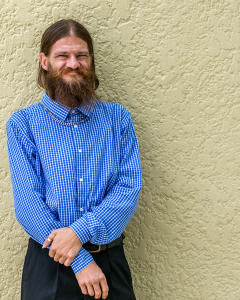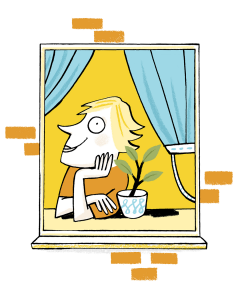When COVID struck last year, more than 40,000 Australians were housed in emergency accommodation. Melissa Fulton asks, where are they now?
It’s just been like, ‘Is this for real?’” says single mum and Big Issue vendor Jannah on the moment she found out she’d been accepted for transitional housing in Perth. “It was an enormous relief. It was like, ‘Wow! A place to call home.’”
Over the phone, Jannah sounds relaxed, positive, happy. It’s Thursday when we talk, and she just moved in on Monday – to a humble three-bedroom home with a front gate and some friendly neighbourhood birds, including a cheeky mudlark that visits every day. Already, Dakota*, Jannah’s 10-year-old daughter, has turned her bedroom into a TikTok studio, complete with LED lights. “She’s done her own bedroom, her own little design,” says Jannah.
It’s been a long road for the two of them. In August last year, Dakota was diagnosed with a tumour in her foot. She was booked in for surgery and they were staying at Ronald McDonald House when they got the news from their landlord that they were being evicted.
Since then, they’ve been homeless, bounced around between boarding houses, hotels and other crisis accommodation. They did three different two-week placements at Perth’s Beatty Lodge, and a few hotel stays – some of which cost Jannah $130 a night, a huge portion of her income support payments. They lived in a share house for a while but that didn’t work out. Jannah says that if she had a car, they would have slept in it. Jannah and Dakota were able to get help in the short term, from emergency housing providers, but when it came to secure long-term accommodation, there was just nowhere to go; there were no suitable rentals available, no social housing.
We’re in the throes of a housing crisis. Jannah and Dakota are among the 155,000-plus households on waiting lists for social and public housing nationwide.
“It’s really, really tough out there,” says Jenny Smith, CEO of the Council to Homeless Persons, which cites a lack of affordable housing as the single biggest cause of homelessness in this country – a problem that has only increased since the onset of the pandemic.
So how did we get here? One of the few silver linings of COVID was that it put the right to housing back on the agenda. Nationwide, when the pandemic struck, governments snapped into action, adopting a public health response to homelessness, securing and funding emergency short-term accommodation for Australians without a safe, secure place to call home – mostly in hotels and student accommodation. A UNSW study found that some 40,000 Australians in New South Wales, Victoria, South Australia and Queensland were given emergency accommodation between mid-March and September last year. JobKeeper payments and the doubling of JobSeeker, coupled with eviction moratoriums and restrictions on rental increases helped stave off disaster, protecting vulnerable Australians against the pandemic. It suggested a solution to homelessness was possible.
The problem is that even before the pandemic, we were in a state of crisis. More than 116,000 Australians are homeless on any given night, and 15,800 of them are children under 12, like Dakota. In the 12 months before COVID, some 290,000 people received support from homelessness services, an increase of 14 per cent in four years, while another 250 people were turned away by emergency homelessness services each night due to a shortage of beds and a system buckling under the weight of demand.
Now, with the winding back of many of the temporary crisis supports, coupled with the continued social and economic costs of the virus, we’re facing a substantial risk of increasing homelessness, according to a University of Melbourne study – especially among young people. Of those 40,000 people given emergency accommodation during the pandemic, only one third transitioned into more permanent housing.
Following the recent lockdowns in NSW and Victoria, ACOSS reported that the demand for emergency relief services has increased by more than 800 per cent. “Requests for food, emergency relief and financial support have spiked significantly during lockdowns, while demand for housing support, mental health and family violence services have been increasing steadily over the course of the pandemic and are now at record levels,” says David Spriggs, CEO of Infoxchange Group, which operates Ask Izzy, a mobile app that connects people in need with services.
“I would say I’ve observed in my personal interactions that people are inclined to think that something’s been done about homelessness, that homelessness has been solved, if you like, by the short-term hotel response,” says Jenny Smith. “And I’ve had to let them know that actually the fundamentals in our country have not changed in the slightest. We’ve missed a huge opportunity not to have a national initiative in relation to social housing.”

“I sleep where I work – right out the front of 7-Eleven,” says Big Issue vendor Nathan from Brisbane. “As a homeless person, male or female, it’s safety first. And because I work there as well during the day, it’s a lot more plausible for me to actually sleep there. Because you never know, someone might actually turn up and say ‘Hey, I’ve got a room available here. You can stay here, or here’s a feed.’ It’s little things.”
When I call Nathan, he’s just checked into a hotel room. They charge a weekly rate of $300 a room, and he springs for it when he can. He’s been on the waiting list for social housing for 10-plus years. In that time, he’s slept rough, on couches, and in a boarding house. When Brisbane locked down earlier this year, he was put up in a hotel by Micah Projects, but when lockdown finished, he no longer had a roof over his head, and he was back to sleeping on his pitch.
“It’s more stressful than anything else, you know?” says Nathan of living homeless. “And when you’re stressed out like that, and you’re trying to get a place, it does take it out of you – you’re exhausted.”
It’s clear, Australia’s housing system isn’t working for everyone. With real-estate prices soaring to record highs, it’s locking people out of home ownership. Just 50 per cent of households aged 25-55 are expected to own a home by 2040, compared to 60 per cent in 1981, according to the Australian Housing and Urban Research Institute. For young people, the news is even worse: for those in the 25-to-34 bracket, home ownership dropped by 28 per cent between 2002 and 2015, to around 45 per cent.
“We’re seeing a wealth-creation event for the haves who can afford to buy another property at the moment,” says Jenny Smith. “But for people on low incomes, it’s a difference between being able to just put a roof over your head, and not.”

With more than a third of us now renting, demand has meant rental properties are less affordable than ever. Across the country, the median rent of houses and units has increased 6.6 per cent over the last 12 months. In regional areas, it’s even more extreme: rents have surged by 11.3 per cent – the biggest hike on record – as tree-changers flee the city during the pandemic. In Perth, where Jannah and her daughter live, the median rent jumped 16.7 per cent. It’s perhaps unsurprising that Anglicare Australia’s latest Rental Affordability Snapshot found that of the 74,226 rental listings across the country on a given weekend in March, only three were affordable for a single person on JobSeeker ($620.80 per fortnight). For those on Youth Allowance ($512.50 per fortnight), there were none.
Without more affordable homes, the options are limited for those struggling to afford private rents. Over 1.5 million Australians are living with housing stress, stretched by rent or mortgage payments totalling more than 30 per cent of their income. It’s why housing bodies and homelessness providers are calling on all levels of government to invest in affordable and social housing to meet the shortfall of 600,000 homes needed to satisfy national demand.
“[Social housing] is an asset to the community and it provides jobs,” adds Smith. “Providing social housing and increasing the JobSeeker payment [means] people can live, and we’re not all just bouncing people around temporary outcomes.”
The pandemic has prompted governments to consider long-term housing solutions. At the end of last year, the Victorian state government announced its $5.3 billion “Big Housing Build”, which aims to create 12,000 homes in four years, with 9300 of these being social housing. New South Wales has allocated $812 million to social housing and homelessness services, including a pledge to build 800 social housing dwellings.
Meanwhile, back at Jannah and Dakota’s place, they’ve been sleeping better, getting up early and starting to build a routine, alive to all the simple pleasures that come with a stable home. “It’s so good to cook a meal again!” says Jannah. “Like last night, I could use an oven instead of a fry pan.” She made Dakota’s favourite Dino snacks. “I’m looking forward to stability, getting back on track. Hopefully we can get some pets here – Dakota’s asked our Salvation Army caseworker if we can get a chicken coop and some chickens.” Dakota’s recovering well and is happy to be back at school, and Jannah’s looking forward to getting back to her studies too – she’s working towards Certificate III in Social Work, Community Services and Domestic and Family Violence. “This is for real now,” says Jannah. “I’ve got my little humble home. A place to call home, I call it.”
* Name changed.
By Melissa Fulton, Deputy Editor.
First published in The Big Issue, ed#642.
Illustration by Michel Streich.
